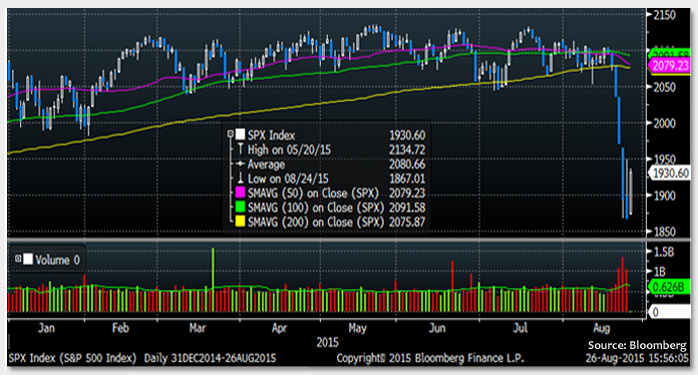In late May, I wrote a post titled "Market Dynamics Changing. Caution Ahead!" At that time, credit, commodities and foreign exchange markets were all sending warning signals, while the equity markets were remaining relatively calm. Now, the market volatility has finally caught up in the equity markets and we have been experiencing some of the worst selloffs since the 2008 financial crisis.
Over the last six years, we have had one of the greatest bull markets in history. After a prolonged bull run, money managers tend to have higher beta in their portfolios, causing them to shift to a "buy-the-dip" mentality. Risk management has not been rewarded in the last several years.
People who trade in the market decide the behavior of the market. I think one reason the equity market is slow to react to global market volatility is because of this widespread "buying-the-dip" mentality. This strategy has stopped working lately. On Monday, when we rallied from opening down 1100 points to only being down 100 points in the Dow Jones Industrial Average, it felt like the old playbook of buying on the reversal was working again. However, the Dow ultimately ended Monday's trading session down 580 points. The same thing happened on Tuesday, when the markets opened in the green, just as the playbook would say, only to end the day in the red.
This change of market dynamics is a warning sign that times may be different. To navigate this market, I offer a few suggestions:
For those who panic: If you panic, be aware of it and don't make important decisions under panic. The way to lose money is to be caught on the wrong foot in an investment; the way to lose a lot of money is to panic and overtrade to try to make the money back.
For people who want to try and catch a falling knife: Buy on strength and buy slowly. History shows that the stocks that go down the least during a correction tend to go up the fastest on a rebound. Human nature is to buy beaten down stocks, but that's not the right way to do this.
For the average investor: Making decisions in this kind of volatility is extremely hard, and the odds of making bad decisions can be high. Doing nothing is not necessarily a bad choice. One thing people talk about a lot is how to make good decisions within a tough environment. However, when we make decisions, it's important to try and think ahead and avoid having to face tough situations down the road.
Key Takeaway: During this heightened market volatility, it is important to stay calm. For people who have a long-term investment horizon, slowly buying high-quality names on weakness is a good way to accumulate assets. For people who are already at full position, doing nothing is not a bad choice. When you make investment decisions, try to think ahead to avoid facing tough decisions down the road. It's a good way to improve investment performance … and quality of life.
The material provided here is for informational use only. The views expressed are those of the author, and do not necessarily reflect the views of Penn Mutual Asset Management.
This material is for informational use only. The views expressed are those of the author, and do not necessarily reflect the views of Penn Mutual Asset Management. This material is not intended to be relied upon as a forecast, research or investment advice, and it is not a recommendation, offer or solicitation to buy or sell any securities or to adopt any investment strategy.
Opinions and statements of financial market trends that are based on current market conditions constitute judgment of the author and are subject to change without notice. The information and opinions contained in this material are derived from sources deemed to be reliable but should not be assumed to be accurate or complete. Statements that reflect projections or expectations of future financial or economic performance of the markets may be considered forward-looking statements. Actual results may differ significantly. Any forecasts contained in this material are based on various estimates and assumptions, and there can be no assurance that such estimates or assumptions will prove accurate.
Investing involves risk, including possible loss of principal. Past performance is no guarantee of future results. All information referenced in preparation of this material has been obtained from sources believed to be reliable, but accuracy and completeness are not guaranteed. There is no representation or warranty as to the accuracy of the information and Penn Mutual Asset Management shall have no liability for decisions based upon such information.
High-Yield bonds are subject to greater fluctuations in value and risk of loss of income and principal. Investing in higher yielding, lower rated corporate bonds have a greater risk of price fluctuations and loss of principal and income than U.S. Treasury bonds and bills. Government securities offer a higher degree of safety and are guaranteed as to the timely payment of principal and interest if held to maturity.
All trademarks are the property of their respective owners. This material may not be reproduced in whole or in part in any form, or referred to in any other publication, without express written permission.


